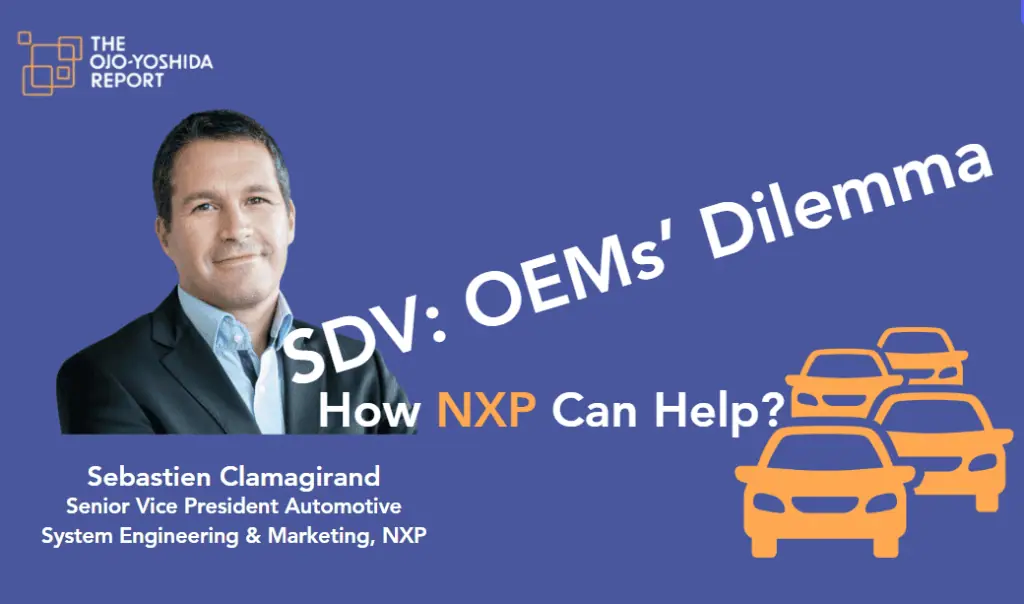
By Junko Yoshida
Our Guest for Episode 4 in our weekly “Dig Deeper on SDV” video podcast series is Sebastien Clamagirand, senior vice president, automotive system engineering & marketing at NXP Semiconductors.
This episode will focus on the dilemma software-designed vehicles (SDV) presents to all car OEMs, a problem NXP believes it can mitigate.
NXP, a leading automotive chip supplier, has given serious thought to vehicular evolution — how cars change as time goes by.
The company takes pride in having led the charge on the evolution of the MPUs that must come deeply integrated with safety and security. Integrating cores is hard but can be done. But “the hardest is to ensure freedom from interference,” said Clamagirand.
And then there’s an evolution of ECUs. Its conversations with OEMs has made the automotive chip vendor keenly aware that individual carmakers, as they venture into SDVs, are in a dire need of a scalable and flexible platform with multiple options.
Until several years ago, the auto industry appeared to focus on integrating systems and chips for ADAS systems and In-Vehicle Infotainment (IVI) — a.k.a the digital cockpit. The goal appears appealing to consumers that there are new apps that can run on the IVI platform.
However, the industry has already moved on. The SDV is no longer about just chasing opportunities to download cool “apps” on digital cockpit.
Rather, automakers today face “a complete change of mindset,” which requires them to rearchitect an entire vehicle, explains Clamagirand. The “software-defined” concept covers everything from central compute, ADAS and IVI to domain/zonal control, connectivity, digital cluster, powertrain chassis and vehicle security.
So, among chip companies, who’s gonna win the SDV race?
Mobileye, Qualcomm and Nvidia will continue their edge in ADAS, digital cockpit and central compute. But when the objective is the whole car “going from 100 ECUs to 20 ECUs, you need to have a broader product portfolio that allows you to consolidate,” said Clamagiran.
Making a car software-defined, in theory, makes the design process of a whole car much faster than with strictly hardware-defined vehicles. Given the growing global EV competition from China, NXP’s Clamagiran said, “You can’t continue to take four or five years to develop a new car” anymore.
Our previous episodes on this Dig Deeper on SDVs series are now available on YouTube.
Phil Amsrud, associate director, Automotive, S&P Global Mobility, set the stage with an overview of software-defined vehicles, including solutions to mysteries like: What is it? Who’s it for? and Why do we need it?
Episode 1: Plabyback for Episode 1
Jack Weast, Intel Fellow and VP and GM at Intel Automotive, discuss why Intel is back in the automotive market, and how the processor giant believes it can leverage its data center experience to SDVs. Episode 2 is a unique opportunity to hear from Weast, who’s now shepherding Intel’s global automotive business from Beijing.
Episode 2: Playback for Episode 2
Phil Koopman, professor at Carnegie Mellon Univ., best known for his expertise in autonomous vehicle safety, teaches embedded system design and leads research on safe and secure embedded systems. In this episode, he weighs in on the SDV by asking his signature question: #didyouthinkofthat?
Episode 3: Playback for Episode 3
Junko Yoshida is the editor in chief of The Ojo-Yoshida Report. She can be reached at [email protected].
Copyright permission/reprint service of a full Ojo-Yoshida Report story is available for promotional use on your website, marketing materials and social media promotions. Please send us an email at [email protected] for details.
